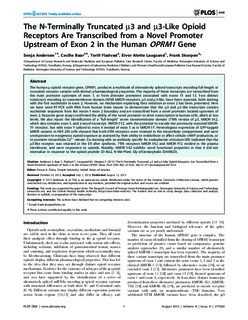| dc.description.abstract | The human µ opioid receptor gene, OPRM1, produces a multitude of alternatively spliced transcripts encoding full-length or truncated receptor variants with distinct pharmacological properties. The majority of these transcripts are transcribed from the main promoter upstream of exon 1, or from alternate promoters associated with exons 11 and 13. Two distinct transcripts encoding six transmembrane domain (6TM) hMOR receptors, µ3 and µ3-like, have been reported, both starting with the first nucleotide in exon 2. However, no mechanism explaining their initiation at exon 2 has been presented. Here we have used RT-PCR with RNA from human brain tissues to demonstrate that the µ3 and µ3-like transcripts contain nucleotide sequences from the intron 1-exon 2 boundary and are transcribed from a novel promoter located upstream of exon 2. Reporter gene assays confirmed the ability of the novel promoter to drive transcription in human cells, albeit at low levels. We also report the identification of a “full-length” seven transmembrane domain (7TM) version of µ3, hMOR-1A2, which also contains exon 1, and a novel transcript, hMOR-1Y2, with the potential to encode the previously reported hMOR-1Y receptor, but with exon Y spliced to exon 4 instead of exon 5 as in hMOR-1Y. Heterologous expression of GFP-tagged hMOR variants in HEK 293 cells showed that both 6TM receptors were retained in the intracellular compartment and were unresponsive to exogenous opioid exposure as assessed by their ability to redistribute or affect cellular cAMP production, or to promote intracellular Ca2+ release. Co-staining with an antibody specific for endoplasmic reticulum (ER) indicated that the µ3-like receptor was retained at the ER after synthesis. 7TM receptors hMOR-1A2 and hMOR-1Y2 resided in the plasma membrane, and were responsive to opioids. Notably, hMOR-1A2 exhibits novel functional properties in that it did not internalize in response to the opioid peptide [D-Ala2, N-Me-Phe4, Gly-ol5]enkephalin (DAMGO). | nb_NO |
